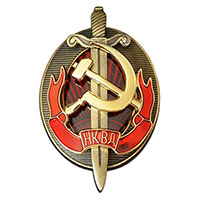Grigory Moiseevich Mairanovsky
Grigory Moiseyevich Mayranovsky (Russian: Григо́рий Моисе́евич Майрано́вский), 1899 - 1964, functionary of the NKVD People's Commissariat of Internal Affairs of the USSR (NKVD, russian: Наро́дный комиссариа́т вну́тренних дел) – a central state organ existing under this name in the years 1917–1946. He became a symbol of all crimes committed by the Soviets in the public consciousness., colonel of the medical service [MGB USSR], communist criminal, known as "Doctor Death". Professor of medicine.
People's Commissariat of Internal Affairs of the USSR (NKVD, russian: Наро́дный комиссариа́т вну́тренних дел) – a central state organ existing under this name in the years 1917–1946. He became a symbol of all crimes committed by the Soviets in the public consciousness., colonel of the medical service [MGB USSR], communist criminal, known as "Doctor Death". Professor of medicine.
Born into a Jewish family, he studied and later taught medicine, and began his career as head of an outpatient clinic in a Moscow factory. After starting to work for the NKVD, he headed the secret toxicology spec-laboratory of the Pharmacology Department at the Bach Institute of Biochemistry in Moscow. In close consultation with BeriaLavrentiy Pavlovich Beria (1899 - 1953) - a Soviet communist activist of Georgian origin, a communist criminal, head of the NKVD, who was largely responsible for the "great purges" of the Stalinist period. One of the main perpetrators of Stalinist crimes. Directly responsible for the murder of Polish officers in Katyn. The peak of his influence fell on the period of World War II and immediately after it. After Stalin's death, he was the author of the most liberal project of systemic changes in the USSR. As a result of a conspiracy against him, he was removed from his post and executed. and [Merkulov], while head of Laboratory No. 1 (1938-1946), he initiated the NKVD's secret poisoning program. He conducted experiments on prisoners sentenced to death, murdering them with various poisons. He tested sulphur iperite, digitoxin, colchicine, thallium, arsenic compounds, potassium and sodium cyanide, aconitine (he confessed to murdering 10 people with it), strychnine and curare. His secret doctoral thesis, defended in 1940, was entitled "Biological activity of the products of mustard gas interaction with skin tissues". Human skin of course.
.In 1942, Mairanovsky made another discovery: under the influence of certain doses of ricin (a protein toxin of plant origin), the "subject" begins to be honest. The NKVD leadership, interested in the emergence of a new effective tool for investigative work, gave the green light for further research. It took two years to experiment with obtaining truthful confessions. Interrogations with the drugs took place not only in the laboratory, but also in Lubianka prisons No. 1 and No. 2, and reportedly had some success. But most of the time ricin was attributed the role of the killer.
In 1949 Majranovsky was involved in larger projects. At the behest of Beria, he developed mechanisms for poisoning with dusty poisonous substances that could be used in crowds and lead to the death of many people at once.
The exact number of victims of Mayranovsky's experiments is difficult to determine. Historians estimate it at 150 to 300 people. KGB colonel [Vladimir Bobrenev], who had access to Beria's investigative files, claims that most of the victims were criminals, but German and Japanese prisoners of war, Polish, Korean and Chinese citizens were also among those killed.
[Pavel Sudoplatov], a former NKVD employee, wrote that Mairanovsky and employees of his group were involved in carrying out death sentences and liquidating unwanted political opponents. Mairanovsky personally participated in the assassinations as a member of Sudoplatov's team; his victims were;
- Isaiah Oggins - an American citizen who worked for the NKVD abroad and was arrested on suspicion of double-dealing;
- a Polish Jew, engineer Nauma Samet working for military intelligence, who had established contacts with the British and intended to emigrate to Palestine,
- Ukrainian activist Alexander Shumsky, one of the leaders of the Ukrainian national movement, was taken to hospital where, according to the official report, he died of heart failure,
- Teodor Romza, archbishop of the Ukrainian Unity Church in Uzhgorod,
- Raoul Wallenberg, a Swedish diplomat who was transferred to a special room in Labor-X, where he received a lethal injection under the pretext of medical treatment.
For his service in the name of "building" Soviet communism, he was awarded the Order of the Red Star, the Order of the Mark of Honour and the badge "Distinguished NKVD Officer".
In 1951, Mairanovsky and many of his colleagues were unexpectedly arrested on charges of negligence, abuse of office, illegal possession of poisons and, worst of all, a Zionist plot to seize power and destroy the leaders of the state. During the interrogations, the chief poison specialist proved to be very talkative and was eager to share his achievements and ways of eliminating the unwanted "subversive element". I must say that I myself feel terrible when I recall all this
. Mairanovsky was sentenced to 10 years in prison. He served his sentence in Vladimir prison. Ironically, the same prison housed the Nazi criminal and colleague of the Soviet "Doctor Death", one of Auschwitz's most feared doctors, Karl Klauberg. After his release in 1962, Mairanovsky moved to Machachkala, where he worked at the local research institute until the end of his days. In 1964 he suddenly died. The diagnosis was easy to predict: acute heart failure.
https://en.wikipedia.org/wiki/Grigory_Mairanovsky
https://pl.wikipedia.org/wiki/Grigorij_Majranowski